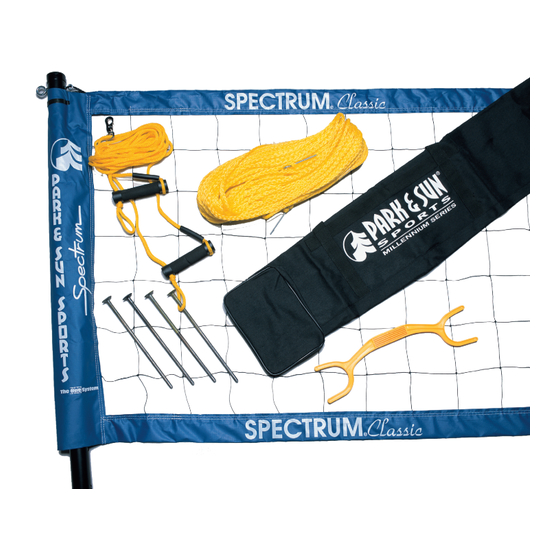
Summary of Contents for Park & Sun Sports Spectrum Classic
- Page 1 w w w . p a r k s u n . c o m 8 0 0 - 7 7 6 - 7 2 7 5 Models: Set Name: TS-CL Spectrum Classic ® TS-2MS Spectrum 2000 ® *TS-CL - Spectrum Classic Shown ® 2150 S Tejon St • Englewood, CO 80110 office 303.935.8449 • fax 303.935.8872...
- Page 2 Spectrum Sets Include 1. Telescopic, push button, aluminum poles 2. Three height adjustments: 8’ Men, 7’8” 3. Co-ed, 7’4-1/8” Women 4. 3’ x 32’ professional sleeve net 5. “C” Clips (Pole/net clip) 6. Pull-down guyline system 7. Forged steel ground stakes 8. Pre-measured boundary with corner anchors 9. Equipment bag and cord winder Guylines Attach the swivel clip to the top of the outside pole [Diagram 1A], to the large eyebolt. Holding the pole upright, extend the guylines out to 45 degrees (approximately 8-10 feet apart) and anchor with ground stakes [Diagram 2A & 3A] . Classic Spectrum Diagram 2A Diagram 3A Diagram 1A office 800-776-7275 • fax 303-935-8872...
- Page 3 Net Tensioning Lean the base of the pole towards the inside center of the court approximately 18”, Pull- down on the guyline tension ring or handle. Stand the pole upright. This procedure provides maximum net tension [Diagram 1B]. Diagram 1B Boundary Setup Unwind the boundary cord onto the playing area. The boundary is pre-measured with the center pole markers and four corner anchors. The standard and current volley- ball court dimensions are 30’ x 60’ [Diagram 1C].
- Page 4 Scoring: Games are usually played to 11 or 15 points and should be determined before play begins. Court switches or exchanging courts occur at specified times during the game. In a 15-point game, courts are exchanged each time the total number of scored points is a multiple of 5. In an 11-point game, teams exchange playing courts each time the total number of scored points is a multiple of 4. Rally Point Scoring: In rally point scoring, either the serving or receiving side scores a point whenever a team fails to serve properly, return the ball, or commits any other fault. Ball Play: • Ball in: The ball is “in” when, after being put in play, its first contact with the ground is on the playing court or a boundary line. • Ball out: The ball is out when after being put in play, its first contact with the ground is completely outside the playing court. - It touches an object outside the court, an overhead object or a person out of play. - It touches the antennas, ropes, posts or the net outside the antenna. Team Contacts: • Each team is entitled to a maximum of three contacts to return the ball to the opponents. • A player may not contact the ball consecutively, except during or after a block or at a team’s first contact. Contact Characteristics: • A player may touch the ball with any part of the body. • The ball must be contacted cleanly and not held, lifted, pushed, caught, carried or thrown. • The ball cannot roll or come to rest on any part of a player’s body. • An exception is allowed during the defensive play of a hard driven ball. At this time, the ball may be momentarily lifted or pushed. Attack Hit: • All actions directing the ball toward the opponent’s playing area, except the acts of serving and blocking, are attack hits. • You cannot contact the ball within the playing space of the opponents. Block: • Blocking is an action that deflects the ball coming from the opponent by a player and/or players at the net. • For doubles and triples, blocking does constitute as a contact and any player may make contact of the ball after the block. • For four-person and six-person play, blocking does not constitute a team contact. Any player may make the first contact of the ball after the block. Simultaneous Contact: • When two blocking teammates touch the ball simultaneously, it is considered one contact and any player may make next contact. Faults: • Assisted Hit: A player takes support from a teammate or any object in order to reach the ball.
